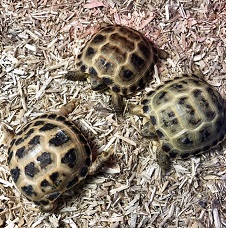Afghan Tortoise (Testudo horsfieldii)
Classification: Introduced Species - While the Afghan Tortoise has been seen and identified in several states at this time there are no records of any breeding populations in the wild. Sightings of this species are most likely of released or escaped pets that were imported for the pet trade.
Description: The Afghan tortoise has a rounded upper shell (carapace) that is almost as broad as it is long. The upper shell varies in colour from uniformly light brown to yellowish-brown with extensive dark brown markings on each scute, while the lower shell (plastron) is black with yellow seams. The head and limbs are yellowish-brown, with the jaws being noticeably darker and the neck, especially in younger specimens, tending to be lighter (more yellowish) in colour. The front legs are heavily armoured with prominent overlapping scales. Spur-like scales are present on each heal and blunt tubercles on each thigh and the tail ends in a horny claw. Unlike all other Testudo tortoises, which have five toes on their forelimbs, this species only has four, resulting in one of its common names, the 'four-toed tortoise'.
The Russian tortoise is a small tortoise species, with a size range of 5 to 10 inches. Females grow slightly larger (6 to 10 inches) to accommodate more eggs. Males average 5 to 8 inches. Russian tortoises are sexually dimorphic. Males tend to have longer tails generally tucked to the side, and longer claws; females have a short, fat tail, with shorter claws than the males. The male has a slit-shaped vent (cloaca) near the tip of its tail; the female has an asterisk-shaped vent (cloaca). Russian tortoises have four toes. Coloration varies, but the shell is usually a ruddy brown or black, fading to yellow between the scutes, and the body is straw-yellow and brown depending on the subspecies.
Habitat: Native to arid, barren habitats such as rocky deserts and hillsides, as well as sandy steppes and grassy areas close to springs. Winters in these environments can be particularly harsh and cold, with temperatures in much of the tortoise's range well below freezing.
Range: Found from the Caspian Sea southward through Iran, Afghanistan and Pakistan, and eastward through Kazakhstan to Xinjiang, China.
Found in these States:
CA |
CO |
GA |
VA
Diet: The diet consists of herbaceous and succulent vegetation, including grasses (green and dried), twigs, flowers, fruits and the flesh leaves and stems of native and cultivated plants.
Reproduction: The courtship and mating ritual is a little unusual, in which the male repeatedly circles the female, then stops to face her head-on. The neck of the male is extended, while the head is rapidly jerked up and down, accompanied by occasional biting and ramming of the female by the male. A clutch of two to six eggs are laid in May or June, and a further two, or even three, clutches may be laid the same season. Hatchlings usually emerge 80 to 110 days later, in August or September, although sometimes they spend the winter in the nest and do not emerge until the following spring.
Status: Its listing on Appendix II of CITES helps regulate the numbers of this species that can be exported. However, CITES quotas still permit Uzbekistan to export 22,000 wild-caught specimens, Tajikistan 20,000 wild-caught specimens and Kazakhstan 40,000 live specimens a year. Stabilization of the political climate and education of local peoples would contribute to a more promising future for the Afghan tortoise.
Subspecies: Three are recognized. It is unknown which subpsecies is repsent in the United States.
»» Kingdom: Animalia - Animals
»» Phylum: Chordata - Chordates
»» Subphylum: Vertebrata - Vertebrates
»» Class: Reptilia - Reptiles
»» Order: Testudines - Turtles & Tortoises
»» Family: Testudinidae - Tortoises
»» Genus: Testudo
»» Species: Testudo horsfieldii - Afghan Tortoise
»» Subspecies:
»» Kazachstan Steppe Tortoise - ( T. horsfieldii kazachtanica)
»» Kopet-Dag Steppe Tortoise - ( T. horsfieldii rustmovi)
»» Un-Named Subspecies - ( T. horsfieldii horsfieldii)
This article uses material from the Wikipedia article "Russian Tortoise", which is released under the Creative Commons Attribution-Share-Alike License 3.0. Content may have been omitted from the original, but no content has been changed or extended.
|








